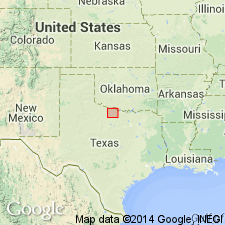
- Usage in publication:
-
- Bluff bone bed
- Modifications:
-
- Original reference
- Dominant lithology:
-
- Bones
- AAPG geologic province:
-
- Palo Duro basin
Summary:
Pg. 35-42. Bluff bone bed. Calcareous bed, 0 to 5 feet thick, consisting of sand, fragments of fish scales and bones, and rolled lumps of marly clay, embedded in matrix of lime and ocherous material and many fish scales and bones, or by conglomerate of rolled lumps of calcareous and clayey material embedded in sandy matrix containing fragments of bones and fish scales. Member of Wichita formation, lying 32 feet below top in southwestern part of Wichita County, central northern Texas. [Fossils listed. Age is Permian.]
[Named from Bluff Creek, south of Electra, Wichita Co., central northern TX.]
Source: US geologic names lexicon (USGS Bull. 896, p. 223).

- Usage in publication:
-
- Bluff bone bed
- Modifications:
-
- Revised
- AAPG geologic province:
-
- Palo Duro basin
Summary:
Pg. 169, 173. Bluff bone bed. Included this bed in Belle Plains formation of Wichita group. Age is Permian.
Source: US geologic names lexicon (USGS Bull. 896, p. 223).
For more information, please contact Nancy Stamm, Geologic Names Committee Secretary.
Asterisk (*) indicates published by U.S. Geological Survey authors.
"No current usage" (†) implies that a name has been abandoned or has fallen into disuse. Former usage and, if known, replacement name given in parentheses ( ).
Slash (/) indicates name conflicts with nomenclatural guidelines (CSN, 1933; ACSN, 1961, 1970; NACSN, 1983, 2005, 2021). May be explained within brackets ([ ]).

